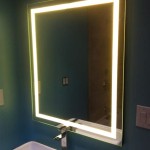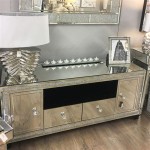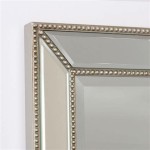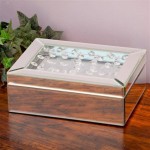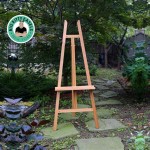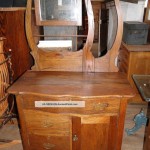What Is a Beveled Mirror?
A beveled mirror distinguishes itself from standard mirrors through a decorative edge created by grinding and polishing the glass surrounding the reflective surface. This angled edge, typically ranging from half an inch to two inches in width, adds depth and visual interest, transforming a simple mirror into an elegant decorative element. The beveled edge refracts light, producing a prism-like effect that can enhance the aesthetic appeal of any room.
The creation of a beveled mirror is a multi-step process that requires specialized machinery and skilled craftsmanship. Initially, a large sheet of mirror glass is cut to the desired dimensions. Subsequently, the edges are ground down at a specific angle, creating the bevel. The grinding process uses abrasive wheels of varying grits to gradually refine the edge and remove any imperfections. Following grinding, the beveled edge undergoes polishing to achieve a smooth, lustrous finish that maximizes light refraction and reflection. The quality of the bevel depends on the precision of the grinding and polishing stages, as well as the expertise of the artisans involved.
Beveled mirrors are available in a wide variety of shapes, sizes, and styles. Common shapes include rectangular, square, oval, and round, while custom shapes can also be created to accommodate specific design requirements. The size of a beveled mirror can range from small accent pieces to large statement mirrors that dominate an entire wall. Frame options vary from frameless designs that highlight the beveled edge to ornate frames crafted from wood, metal, or composite materials.
Enhanced Aesthetics and Visual Appeal
The primary advantage of a beveled mirror lies in its enhanced aesthetic appeal. The beveled edge adds a layer of sophistication and elegance to the mirror, making it a more visually engaging piece compared to standard mirrors with flat edges. The angled edge catches and refracts light, creating subtle highlights and shadows that contribute to the overall visual interest. This effect is particularly noticeable in well-lit environments, where the light refraction creates a subtle, sparkling effect around the periphery of the mirror.
The beveled edge also adds a sense of depth and dimension to the mirror. The angled surface creates a visual separation between the reflective surface and the surrounding wall, making the mirror appear to float slightly. This effect can be particularly effective in smaller rooms, where it can help to create the illusion of greater space. Furthermore, the beveled edge can complement a variety of design styles, from traditional and classic to contemporary and modern. Its versatility makes it a popular choice for homeowners and designers alike.
Frameless beveled mirrors offer a clean, minimalist aesthetic that seamlessly integrates into various interior design schemes. These mirrors emphasize the beveled edge as the primary decorative element, allowing its light-refracting properties to take center stage. Framed beveled mirrors, on the other hand, can provide a more traditional or ornate look. The frame material, style, and finish can be chosen to complement the existing décor and create a cohesive design scheme.
Versatile Applications in Interior Design
Beveled mirrors find applications in a wide range of interior design settings. They are commonly used in bathrooms, entryways, living rooms, and bedrooms, adding both functionality and aesthetic value. In bathrooms, beveled vanity mirrors are a popular choice, providing both a clear reflection for grooming and a decorative element that enhances the overall ambiance. In entryways, beveled mirrors can create a welcoming and sophisticated impression, while also providing a convenient spot for last-minute appearance checks. In living rooms and bedrooms, beveled mirrors can be used as decorative accents, adding visual interest and reflecting light to make the space feel brighter and more open.
Beyond their use as wall-mounted mirrors, beveled mirrors can also be incorporated into furniture designs. Beveled mirror panels can be used on dresser drawers, cabinet doors, and coffee table tops, adding a touch of elegance and sophistication to these pieces. The beveled edges can create a subtle visual texture and enhance the overall aesthetic appeal of the furniture. Furthermore, beveled mirror tiles can be used to create stunning backsplashes in kitchens or bathrooms. The reflective surface of the tiles can brighten up the space and add a sense of depth, while the beveled edges create a decorative pattern that enhances the overall design.
The versatility of beveled mirrors extends to their ability to complement various design styles. In traditional settings, beveled mirrors with ornate frames can add a touch of classic elegance. In contemporary spaces, frameless beveled mirrors can provide a clean, minimalist look. In transitional designs, beveled mirrors with simple frames can bridge the gap between traditional and modern styles. The adaptability of beveled mirrors makes them a valuable tool for interior designers looking to create cohesive and aesthetically pleasing spaces.
Installation and Maintenance Considerations
The installation of a beveled mirror requires careful consideration of several factors. The size and weight of the mirror will influence the choice of mounting hardware and the required support. Smaller, lighter beveled mirrors can be hung using standard picture-hanging hooks or wire, while larger, heavier mirrors may require more robust mounting systems, such as Z-bar clips or specialized mirror mounting brackets. It is crucial to ensure that the mounting hardware is securely attached to the wall and that the mirror is properly supported to prevent it from falling or breaking.
Before installation, carefully measure the intended location and mark the position of the mounting hardware. Use a level to ensure that the mirror is hung straight and plumb. When installing a beveled mirror in a bathroom or other humid environment, it is important to use moisture-resistant mounting hardware and to seal the edges of the mirror to prevent water damage. Applying a bead of silicone sealant along the edges of the mirror can help to protect the reflective surface from moisture and prevent corrosion.
Maintaining a beveled mirror involves regular cleaning to remove dust, fingerprints, and other smudges. Use a soft, lint-free cloth and a mild glass cleaner to wipe the mirror surface. Avoid using abrasive cleaners or scouring pads, as these can scratch the reflective surface. Pay particular attention to the beveled edge, as dust and debris can accumulate in the crevices. A cotton swab dipped in glass cleaner can be used to clean the beveled edge and remove any stubborn dirt. With proper care and maintenance, a beveled mirror can retain its beauty and elegance for many years.

Beveled Glass Frame Mirror Pottery Barn
Beveled Glass Mirrors In Northern Virginia Abc Mirror

Frameless Beveled Rectangle Mirror Better Bevel Made In Usa

Bevel Edge Mirror Diffe Sizes Melbourne Bathroom

Beveled Mirror Egan Interiors

Large Flat Framed Wall Mirror With Double Edge Beveled F Hamilton Hills

Large Simple Rectangular Streamlined 1 Inch Beveled Wall Mirror Premium Silv Com

Beveled Frame Rectangle Wall Mirror Kirklands Home

Square Mirror Bevelled Frameless Saint Gobain Flair Glass

Metal Beveled Mirror
